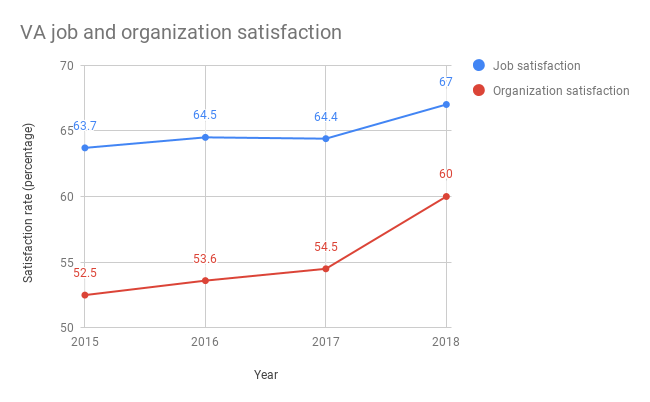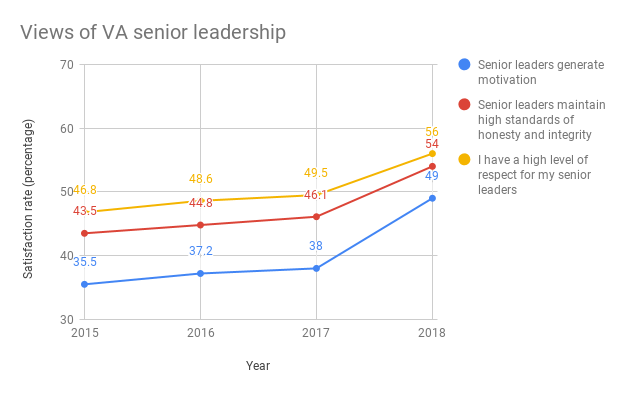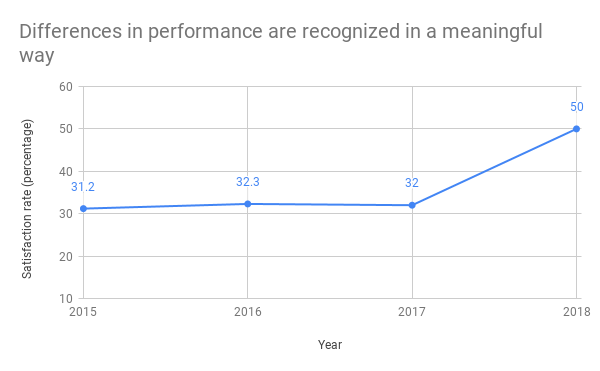
VA sees rising employee engagement in first survey without the FEVS
The results from the Veterans Affairs Department's first, self-reported all-employee survey are in, and they show engagement and morale in its workforce went up...
In a year marked by high-profile leadership turnover, the Veterans Affairs Department says employee engagement and morale in its workforce went up significantly in 2018.
About 67 percent of VA employees said they were satisfied with their jobs, and 60 percent said they were satisfied with their organization, according to the results of its “all-employee survey,” which the department released Thursday.
Comparatively, 64 percent of VA employees in 2017 said they were satisfied with their jobs, while 54.5 percent said they were pleased with the agency.

Roughly 67 percent said this year they’d recommend VA as a good place to work, compared with 62 percent back in 2017.
“VA employees are talented and committed professionals who rally behind a great mission,” Secretary Robert Wilkie said in a statement. “Veterans deserve a VA workforce that demonstrates pride in its work that results in strong customer service, and the survey shows we are making important progress in that direction.”
Wilkie’s statement echoes comments he made in September before the Senate Veterans Affairs Committee, when he described the state of VA as “better,” but not “good or excellent.”
The most recent data comes from VA itself, which this year deviated from how most other federal agencies measure employee engagement and satisfaction among their employees. Rather than using the Federal Employee Viewpoint Survey from the Office of Personnel Management, the department decided to create its own assessment, which does include some questions from the FEVS.
VA’s survey included 30 of the 84 questions that OPM used in last year’s FEVS to measure employee satisfaction and engagement. The inclusion of those questions also means VA can still participate in the Partnership for Public Service’s annual Best Places to Work rankings.
With the FEVS, the department said it wasn’t getting a clear picture of its entire organization of nearly 375,000 employees.
“We need better data, targeted data,” Peter Shelby, VA’s former chief human capital officer, said last summer of the employee engagement surveys. “We’re not a typical government administrative function serving citizens. We are the largest integrated health care system in the world.”
Only 30.7 percent, or 64,394 VA employees, took the 2017 FEVS, according to OPM. About 45 percent of the federal workforce, or 485,000 employees overall, answered last year’s FEVS — nearly 100,000 employees more than the entire VA workforce.
But significantly more VA employees responded to this survey in 2018, according to the department. Roughly 62 percent of the VA workforce, or 235,884 employees, answered the department’s 2018 all employee survey.
Statistically speaking, a larger response rate on this year’s engagement survey may, in part, explain why VA saw serious improvement on some assessment questions. Chief human capital leaders in government have consistently said boosting survey response rates helps agencies gain a fuller, more representative picture of their workforce.
VA leaders issue own assessment to avoid ‘survey fatigue’
In addition, VA leadership has said it opted to issue its own assessment this year to prevent “survey fatigue.” The department had issued employee pulse surveys throughout the year, and VA speculated that the workforce had grown tired and weary of another by the time OPM administered the FEVS during a given year.
To be clear, the data VA released earlier this week only paints a partial picture of the survey it released to employees this year. The department only provided responses to the questions that matched with OPM’s 2017 FEVS; it didn’t include any survey questions or response data that presumably encompasses more of the VA-specific experience.
Governmentwide FEVS results from OPM for 2018 aren’t yet publicly available.
VA made progress on nearly all shared FEVS questions in its 2018 all-employee survey.
Employees’ views of senior leadership rose, though the satisfaction rate still sits relatively low at VA and across government in general. About 56 percent of employees said they have a high level of respect for their senior leaders in 2018, compared to 49.5 percent during the previous year.
Roughly 54 percent of employees said in 2018 their senior leaders maintain high standards of honesty and integrity, compared with 46 percent in 2017.
According to the data, VA leadership continues to struggle to motivate its employees, but satisfaction on this question still rose 11 percent between 2017 to 49 percent in 2018.

In some cases, VA data appears to defy anecdote. About 64 percent of VA employees said they were given a real opportunity to improve, compared with 57.5 percent in 2017.
The data would be certainly be encouraging to VA leadership. Some VA employees, particularly those in the Veterans Benefits Administration, have told both Congress and Federal News Network that rapidly changing performance standards made it difficult to improve.
The American Federation of Government Employees and federal employment attorneys have said VA employees still largely view the department’s year-old Office of Accountability and Whistleblower Protection with a sense of distrust.
More VA employees also said leadership recognized differences in performance in a meaningful way, according to the 2018 data.

According to the 2018 data, 65 percent VA employees also felt comfortable disclosing a “suspected violation of law, rule or regulation without fear of reprisal,” compared to nearly 58 percent in 2017.
This is another telling data point, as a recent Government Accountability Office study found VA whistleblowers were 10 times more likely to receive discipline over their colleagues who hadn’t come forward with a possible disclosure.
Copyright © 2025 Federal News Network. All rights reserved. This website is not intended for users located within the European Economic Area.
Nicole Ogrysko is a reporter for Federal News Network focusing on the federal workforce and federal pay and benefits.
Follow @nogryskoWFED





